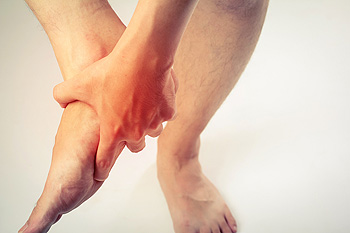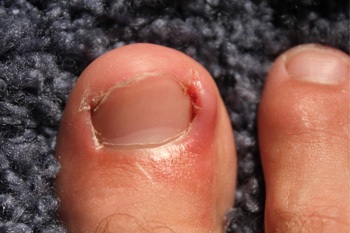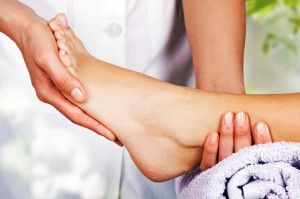
 Tarsal tunnel syndrome occurs in the foot and ankle. It is similar to carpal tunnel syndrome, which occurs in the wrist. Both disorders arise from the compression of a nerve in a confined space. Tarsal tunnel syndrome is a constriction, or squeezing, on the posterior tibial nerve that produces symptoms anywhere on the path of the nerve running from the inside of the ankle into the foot. The posterior tibial nerve is the focus of tarsal tunnel syndrome. This nerve runs down the back of the calf and into the sole of the foot. When tissues around the tarsal tunnel become inflamed, they can swell and press on the nerve, causing severe pain. If you have pain in your foot or ankle and want to identify the source, it is suggested to consult with your local podiatrist. Your podiatrist may prescribe corticosteroid injections, orthoses, and in some cases, surgery to treat this ailment.
Tarsal tunnel syndrome occurs in the foot and ankle. It is similar to carpal tunnel syndrome, which occurs in the wrist. Both disorders arise from the compression of a nerve in a confined space. Tarsal tunnel syndrome is a constriction, or squeezing, on the posterior tibial nerve that produces symptoms anywhere on the path of the nerve running from the inside of the ankle into the foot. The posterior tibial nerve is the focus of tarsal tunnel syndrome. This nerve runs down the back of the calf and into the sole of the foot. When tissues around the tarsal tunnel become inflamed, they can swell and press on the nerve, causing severe pain. If you have pain in your foot or ankle and want to identify the source, it is suggested to consult with your local podiatrist. Your podiatrist may prescribe corticosteroid injections, orthoses, and in some cases, surgery to treat this ailment.
Tarsal tunnel syndrome can be very uncomfortable to live with. If you are experiencing tarsal tunnel syndrome, contact Dr. Stephan J. LaPointe of Georgia Foot & Ankle Specialists . Our doctor can provide the care you need to keep you pain-free and on your feet.
Tarsal Tunnel Syndrome
Tarsal tunnel syndrome, which can also be called tibial nerve dysfunction, is an uncommon condition of misfiring peripheral nerves in the foot. The tibial nerve is the peripheral nerve in the leg responsible for sensation and movement of the foot and calf muscles. In tarsal tunnel syndrome, the tibial nerve is damaged, causing problems with movement and feeling in the foot of the affected leg.
Common Cause of Tarsal Tunnel Syndrome
The Effects of Tarsal Tunnel Syndrome
A physical exam of the leg can help identify the presence of tarsal tunnel syndrome. Medical tests, such as a nerve biopsy, are also used to diagnose the condition. Patients may receive physical therapy and prescriptive medication. In extreme cases, some may require surgery.
If you have any questions please feel free to contact our office located in Rome, GA . We offer the newest diagnostic and treatment technologies for all your foot and ankle needs.
The portion of tissue that is located on the sole of the foot which connects the heel to the toes is known as the plantar fascia. If it should become inflamed, a condition that is referred to as plantar fasciitis may develop. It may happen as a result of an injury that has occurred, or gradually from walking and standing on hard surfaces. Plantar fasciitis may also develop from added weight the feet must endure should the body weight increase, and medical conditions such as flat feet, or feet that roll inward as walking occurs. There are noticeable symptoms that are often associated with this condition. These may include severe pain and discomfort in the heel and surrounding areas, and it may be more painful after a running or jumping activity has been completed. Some patients can find moderate relief when shoe inserts are worn, in addition to performing gentle stretching techniques specifically for the plantar fascia. If you feel you have developed plantar fasciitis, it is strongly advised that you seek the counsel of a podiatrist who can perform a proper diagnosis, and treat this condition.
Plantar fasciitis can be very painful and inconvenient. If you are experiencing heel pain or symptoms of plantar fasciitis, contact Dr. Stephan J. LaPointe from Georgia Foot & Ankle Specialists . Our doctor can provide the care you need to keep you pain-free and on your feet.
What Is Plantar Fasciitis?
Plantar fasciitis is the inflammation of the thick band of tissue that runs along the bottom of your foot, known as the plantar fascia, and causes mild to severe heel pain.
What Causes Plantar Fasciitis?
How Can It Be Treated?
While very treatable, plantar fasciitis is definitely not something that should be ignored. Especially in severe cases, speaking to your doctor right away is highly recommended to avoid complications and severe heel pain. Your podiatrist can work with you to provide the appropriate treatment options tailored to your condition.
If you have any questions please feel free to contact our office located in Rome, GA . We offer the newest diagnostic and treatment technologies for all your foot and ankle needs.
Read more about Plantar FasciitisMany patients who enjoy the sport of running understand the benefits of stretching before running begins, and after it has ended. Research has indicated it may help to strengthen the muscles in the feet and legs, and this may be advantageous in preventing many injuries. An effective stretch is known as toe curling, and this is helpful in maintaining strength in the top of the foot. Additionally, the foot can be trained to move certain toes individually, which is known as toe yoga. It is important to keep the ankles strong, and this can be accomplished by pointing and flexing the feet on a frequent basis. If you would like more information about the benefits of stretching the feet, please schedule a consultation with a podiatrist.
Why Stretching Is Important for Your Feet
Stretching the feet is a great way to prevent injuries. If you have any concerns with your feet consult with Dr. Stephan J. LaPointe from Georgia Foot & Ankle Specialists . Our doctor will assess your condition and provide you with quality foot and ankle treatment.
Stretching the Feet
Stretching the muscles in the foot is an important part in any physical activity. Feet that are tight can lead to less flexibility and make you more prone to injury. One of the most common forms of foot pain, plantar fasciitis, can be stretched out to help ease the pain. Stretching can not only ease pain from plantar fasciitis but also prevent it as well. However, it is important to see a podiatrist first to determine if stretching is right for you. Podiatrists can also recommend other ways to stretch your feet. Once you know whether stretching is right for you, here are some excellent stretches you can do.
It is best to go easy when first stretching your foot and work your way up. If your foot starts hurting, stop exercising to ice and rest the foot. It is advised that you then see a podiatrist for help.
If you have any questions, please feel free to contact our office located in Rome, GA . We offer the newest diagnostic and treatment technologies for all your foot care needs.
Read more about Stretching Your Feet The condition that is known as ingrown toenails happens as a result of the edge of the nail growing into the skin surrounding the nail. It can typically cause severe pain and discomfort, and it may be difficult to wear shoes that are normally worn. The edges of the nail can appear red, swollen, and tender when touched, and it is beneficial to begin treatment as quickly as possible. This can consist of soaking the affected nail in warm water, which is helpful in softening the skin around the nail. This may also make it easier to move the edge of the toenail away from the skin with a piece of cotton. If an ingrown toenail should become infected, surgery may be required to remove a portion of the nail. If you are afflicted with this ailment, it is strongly suggested that you consult with a podiatrist who can offer you proper treatment techniques.
The condition that is known as ingrown toenails happens as a result of the edge of the nail growing into the skin surrounding the nail. It can typically cause severe pain and discomfort, and it may be difficult to wear shoes that are normally worn. The edges of the nail can appear red, swollen, and tender when touched, and it is beneficial to begin treatment as quickly as possible. This can consist of soaking the affected nail in warm water, which is helpful in softening the skin around the nail. This may also make it easier to move the edge of the toenail away from the skin with a piece of cotton. If an ingrown toenail should become infected, surgery may be required to remove a portion of the nail. If you are afflicted with this ailment, it is strongly suggested that you consult with a podiatrist who can offer you proper treatment techniques.
Ingrown toenails can become painful if they are not treated properly. For more information about ingrown toenails, contact Dr. Stephan J. LaPointe of Georgia Foot & Ankle Specialists . Our doctor can provide the care you need to keep you pain-free and on your feet.
Ingrown Toenails
Ingrown toenails occur when a toenail grows sideways into the bed of the nail, causing pain, swelling, and possibly infection.
Causes
Prevention
Because ingrown toenails are not something found outside of shoe-wearing cultures, going barefoot as often as possible will decrease the likeliness of developing ingrown toenails. Wearing proper fitting shoes and using proper cutting techniques will also help decrease your risk of developing ingrown toenails.
Treatment
Ingrown toenails are a very treatable foot condition. In minor cases, soaking the affected area in salt or antibacterial soaps will not only help with the ingrown nail itself, but also help prevent any infections from occurring. In more severe cases, surgery is an option. In either case, speaking to your podiatrist about this condition will help you get a better understanding of specific treatment options that are right for you.
If you have any questions please feel free to contact our office located in Rome, GA . We offer the newest diagnostic and treatment technologies for all your foot and ankle needs.
Read more about Ingrown Toenails Many people have tired feet at the end of a working day. Reflexology can help ease sore feet and may be beneficial in preventing specific foot conditions. During reflexology, a certain amount of pressure is applied to different parts of the feet to ease pain. Stretching the calves during reflexology may also help release tension that can build up in the legs during the day. A foot massage with essential oils can also be therapeutic for the feet and may positively enhance the emotional state of the patient. If you would like to learn more about different types of foot therapy, consult with a podiatrist.
Many people have tired feet at the end of a working day. Reflexology can help ease sore feet and may be beneficial in preventing specific foot conditions. During reflexology, a certain amount of pressure is applied to different parts of the feet to ease pain. Stretching the calves during reflexology may also help release tension that can build up in the legs during the day. A foot massage with essential oils can also be therapeutic for the feet and may positively enhance the emotional state of the patient. If you would like to learn more about different types of foot therapy, consult with a podiatrist.
Foot therapy is often necessary for those recovering from either foot deformities or foot injuries. If you have concerns regarding therapy, Dr. Stephan J. LaPointe of Georgia Foot & Ankle Specialists . Our doctor can provide the care you need to keep you pain-free and on your feet.
Most Common Injuries
People who are active or athletes are prone to a variety of injuries. Therefore, it is often important to take part in physical therapy in order to quickly get back on the right track.
What to Do When Injured
Physical Therapy – This specialized treatment will focus on the affected area, speeding up recovery and the overall healing process. It is a proven method that has helped millions of people return from any injury.
During physical therapy you will undergo regimented training to get back into full form. Training is often very difficult, especially at first when the foot feels weak. Physical therapy often involves:
Basic stretching and twisting exercises – getting the feet’s mobility and flexibility up.
Massaging – the therapist will massage the injured area in order to activate the muscles and relax them.
Strengthening Exercises – this allows the muscles in the affected area to regain their full strength, a vital step towards full recovery.
If you have any questions please feel free to contact our office located in Rome, GA . We offer the newest diagnostic tools and technology to treat your foot and ankle needs.
 A form of arthritis that is referred to as gout is generally accompanied by severe pain and discomfort. Patients who experience this uncomfortable foot ailment often notice swelling and tenderness in and around the joints of the big toe.This is the result of crystals that lodge in the joints of the toes. It is caused by an excess of uric acid in the blood levels. A common reason for this to occur may involve foods that are eaten. There are many foods that have elevated purine levels, and these types of foods can include shellfish, red meat, and drinks that are high in fructose levels. An additional reason why gout attacks can suddenly happen may stem from genetic traits. Many patients choose to have a proper diagnosis performed, which can consist of having fluid drawn and tested from the affected joints, followed by taking proper medication. There are measures that can be implemented which may prevent gout attacks. These can include eating foods that are healthy, and drinking plenty of water daily. If you are afflicted with frequent bouts of gout, please consult with a podiatrist.
A form of arthritis that is referred to as gout is generally accompanied by severe pain and discomfort. Patients who experience this uncomfortable foot ailment often notice swelling and tenderness in and around the joints of the big toe.This is the result of crystals that lodge in the joints of the toes. It is caused by an excess of uric acid in the blood levels. A common reason for this to occur may involve foods that are eaten. There are many foods that have elevated purine levels, and these types of foods can include shellfish, red meat, and drinks that are high in fructose levels. An additional reason why gout attacks can suddenly happen may stem from genetic traits. Many patients choose to have a proper diagnosis performed, which can consist of having fluid drawn and tested from the affected joints, followed by taking proper medication. There are measures that can be implemented which may prevent gout attacks. These can include eating foods that are healthy, and drinking plenty of water daily. If you are afflicted with frequent bouts of gout, please consult with a podiatrist.
Gout is a painful condition that can be treated. If you are seeking treatment, contact Dr. Stephan J. LaPointe from Georgia Foot & Ankle Specialists . Our doctor will treat your foot and ankle needs.
What Is Gout?
Gout is a form of arthritis that is characterized by sudden, severe attacks of pain, redness, and tenderness in the joints. The condition usually affects the joint at the base of the big toe. A gout attack can occur at any random time, such as the middle of the night while you are asleep.
Symptoms
Risk Factors
Prior to visiting your podiatrist to receive treatment for gout, there are a few things you should do beforehand. If you have gout you should write down your symptoms--including when they started and how often you experience them, important medical information you may have, and any questions you may have. Writing down these three things will help your podiatrist in assessing your specific situation so that he or she may provide the best route of treatment for you.
If you have any questions, please feel free to contact our office located in Rome, GA . We offer the newest diagnostic and treatment technologies for all your foot care needs.
Patients who have had a plantar wart are familiar with the pain and discomfort it can cause. It is caused by human papillomavirus, which is known as HPV. It enters the body through small cuts in the skin on the feet, and will typically grow in the heel area. This virus lives in warm and moist environments, which can include public pools, shower room floors, and surrounding areas. A plantar wart is different than most warts because it grows into the heel instead of out. This happens as a result of the amount of pressure the heel endures while standing and walking. Some of the symptoms that are associated with this contagious condition can include heel pain, which can be severe upon arising in the morning, bleeding if it is scraped, and walking may also be affected. If you have a plantar wart, it is suggested that you seek the counsel of a podiatrist who has access to methods for proper removal.
Plantar warts can be very uncomfortable. If you need your feet checked, contact Dr. Stephan J. LaPointe from Georgia Foot & Ankle Specialists . Our doctor will assist you with all of your foot and ankle needs.
About Plantar Warts
Plantar warts are the result of HPV, or human papillomavirus, getting into open wounds on the feet. They are mostly found on the heels or balls of the feet.
While plantar warts are generally harmless, those experiencing excessive pain or those suffering from diabetes or a compromised immune system require immediate medical care. Plantar warts are easily diagnosed, usually through scraping off a bit of rough skin or by getting a biopsy.
Symptoms
Treatment
To help prevent developing plantar warts, avoid walking barefoot over abrasive surfaces that can cause cuts or wounds for HPV to get into. Avoiding direct contact with other warts, as well as not picking or rubbing existing warts, can help prevent the further spread of plantar warts. However, if you think you have developed plantar warts, speak to your podiatrist. He or she can diagnose the warts on your feet and recommend the appropriate treatment options.
If you have any questions please feel free to contact our office located in Rome, GA . We offer the newest diagnostic and treatment technologies for all your foot and ankle needs.
In sports, injuries to the feet and ankles are very common. These  can result from overuse which can almost always be treated with rest, ice and over-the-counter medications. Common foot and ankle conditions include ankle sprains, Achilles tendonitis, turf toe, blisters and calluses, fungal infections and ingrown toenails. Additional foot and ankle injuries associated with playing sports are plantar fasciitis, bursitis, dislocations, fractures, lacerations, sesamoiditis, neuritis, contusions and sever’s disease. All of these conditions and injuries are from the wear and tear of playing sports on a regular basis. As a way of finding the best treatment options for any of these conditions and injuries, it is recommended to consult with a podiatrist at your earliest convenience.
can result from overuse which can almost always be treated with rest, ice and over-the-counter medications. Common foot and ankle conditions include ankle sprains, Achilles tendonitis, turf toe, blisters and calluses, fungal infections and ingrown toenails. Additional foot and ankle injuries associated with playing sports are plantar fasciitis, bursitis, dislocations, fractures, lacerations, sesamoiditis, neuritis, contusions and sever’s disease. All of these conditions and injuries are from the wear and tear of playing sports on a regular basis. As a way of finding the best treatment options for any of these conditions and injuries, it is recommended to consult with a podiatrist at your earliest convenience.
Ankle and foot injuries are common among athletes and in many sports. They can be caused by several problems and may be potentially serious. If you are feeling pain or think you were injured in a sporting event or when exercising, consult with Dr. Stephan J. LaPointe from Georgia Foot & Ankle Specialists . Our doctor will assess your condition and provide you with quality foot and ankle treatment.
Common Injuries
The most common injuries that occur in sporting activities include:
Symptoms
Symptoms vary depending upon the injury and in some cases, there may be no symptoms at all. However, in most cases, some form of symptom is experienced. Pain, aching, burning, bruising, tenderness, tightness or stiffness, sensation loss, difficulty moving, and swelling are the most common symptoms.
Treatment
Just as symptoms vary depending upon the injury, so do treatment options. A common treatment method is known as the RICE method. This method involves rest, applying ice, compression and elevating the afflicted foot or ankle. If the injury appears to be more serious, surgery might be required, such as arthroscopic or reconstructive surgery. Lastly, rehabilitation or therapy might be needed to gain full functionality in the afflicted area. Any discomfort experienced by an athlete must be evaluated by a licensed, reputable medical professional.
If you have any questions, please feel free to contact our office located in Rome, GA . We offer the newest diagnostic and treatment technologies for all your foot care needs.